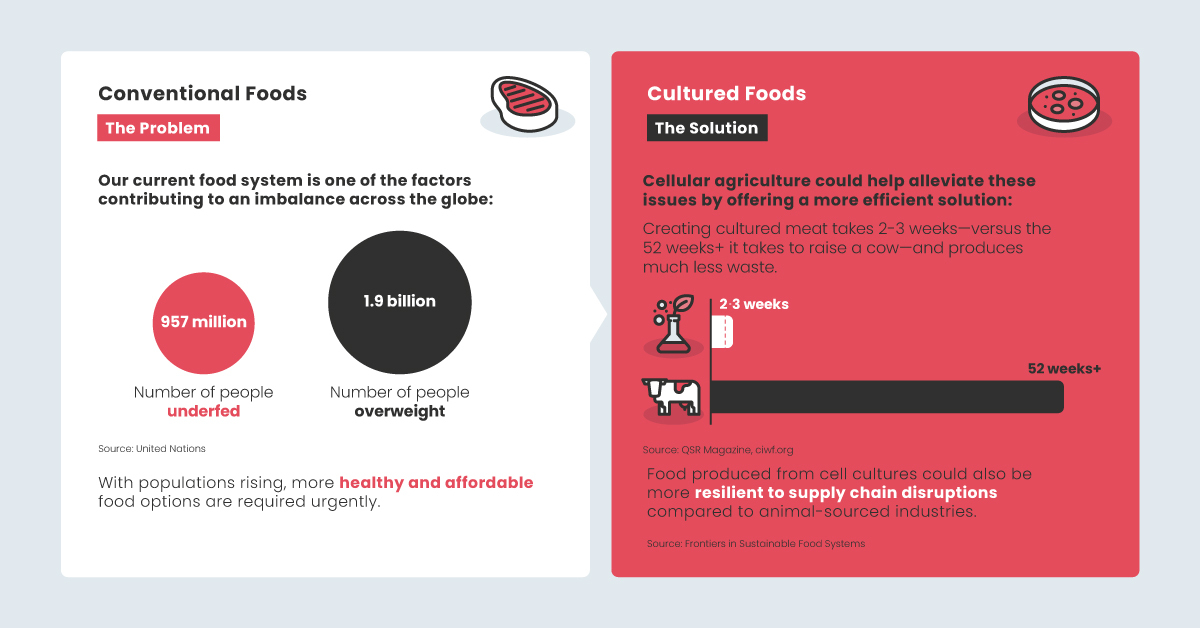5 Reasons Why Cultured Foods Are Here to Stay
The following content is sponsored by CULT Food Science (CSE: CULT)

5 Reasons Why Cultured Foods Are Here to Stay
Imagine a world where humans can thrive without harming any animals for food.
By cutting meat consumption and shifting to a plant-based diet, we could reduce greenhouse gases by 70% by 2050 and spare 105 animals per person each year.
Cellular agriculture has the power to make this shift less daunting. The infographic above from CULT Food Science (CSE: CULT) explores five reasons why foods produced from cell cultures could make this world a reality.
The Case for Cultured Foods
First things first, the term cellular agriculture describes the process of growing animal agricultural products directly from cell cultures instead of using livestock.
Foods produced from cell cultures—also known as cultured foods—can provide a promising solution to a wide range of problems we are currently facing.
Sounds too good to be true? Let’s dive into some of the reasons cultured foods are here to stay:
1. A More Sustainable Food System is Desperately Needed
With populations rising at an unprecedented pace, more healthy and affordable food options are required urgently.
Cultured foods can provide a more efficient solution compared to conventional meat. In fact, it takes just 2-3 weeks to create a cultured meat product compared to the 52 weeks+ it takes to raise a farm animal such as a cow.
Compared to animal-sourced industries, food produced from cell cultures could also be more resilient to supply chain disruptions.
2. Cultured Foods Could Lead to Lower Emissions
Conventional agriculture contributes 15% of all emissions globally, with beef producing the highest level of greenhouse gases per serving.
A cultured foods manufacturing plant on the other hand could produce emissions that are:
- 92% lower than beef
- 52% lower than pork
- 17% lower than chicken
The caveat is that these figures refer to a plant that uses renewable energy. Foods created from cell cultures also require less land and water use, meaning they could be an more environmentally friendly option overall.
3. Cultured Foods Could Soon be Produced at Parity
In 2021, the price of meat, poultry, fish, and eggs shot up by 11.9% in the U.S.—the fastest increase since 1990.
While plant-based alternatives have attempted to disrupt the meat market, these products will not experience price parity until at least 2023.
Because this is unchartered territory, there is a huge opportunity for new companies in the cultured foods space to provide solutions for cost reduction at scale.
“Some experts posit that cultured meat products will be cost competitive with traditional meat products within the decade.”
—Food in Canada
4. A Healthier Alternative to Products on the Market
The long-term consumption of eating meat has proven to be harmful. In fact, there is a clear link between eating red meat and heart disease, cancer, diabetes, and premature death according to Harvard Medical School.
Similarly, while there are many benefits to eating plant-based, some plant-based products on the market may contain fillers, added sodium, and higher saturated fats.
In contrast, cultured foods are grown in a safe and controlled environment which comes with several benefits:
- Cultured foods may be less likely to be contaminated with bacteria like E.coli
- Fewer antibiotics are needed to produce cultured foods as there is little need for livestock
Therefore cultured foods could provide a healthier alternative to both meat and plant-based products in the long-run.
5. Accelerating Research Breakthroughs, Regulation Changes, and Capital Flow
Despite rising populations putting pressure on the food supply chain, meat consumption is in fact shrinking.
This means that the market for conventional meat products will be overtaken by other options like plant-based alternatives and cultured meat as soon as 2040.
To keep up with these major market changes, innovation in stem cell research and tissue engineering is accelerating. A whopping $2 billion in investment has been pumped into the market since 2020 according to Crunchbase.
What’s more, we’re starting to see changes in regulation around the world with Singapore being the first nation to legalize the sale of cultured meat products.
Investing in the Future of Food
CULT Food Science is an innovative investment platform advancing the technology behind the future of food with an exclusive focus on cultured meat, cultured dairy and cell-based foods.
The company’s portfolio spans four continents and includes exposure to a diverse pipeline of:
- Cell lines
- End products
- Scaffolding technology
- Growth medium
- Intellectual property
Want to stay updated?
>>> Click here to subscribe to the CULT Food Science mailing list.
-

 Sponsored3 years ago
Sponsored3 years agoMore Than Precious: Silver’s Role in the New Energy Era (Part 3 of 3)
Long known as a precious metal, silver in solar and EV technologies will redefine its role and importance to a greener economy.
-

 Sponsored7 years ago
Sponsored7 years agoThe History and Evolution of the Video Games Market
Everything from Pong to the rise of mobile gaming and AR/VR. Learn about the $100 billion video games market in this giant infographic.
-

 Sponsored8 years ago
Sponsored8 years agoThe Extraordinary Raw Materials in an iPhone 6s
Over 700 million iPhones have now been sold, but the iPhone would not exist if it were not for the raw materials that make the technology...
-

 Sponsored8 years ago
Sponsored8 years agoThe Industrial Internet, and How It’s Revolutionizing Mining
The convergence of the global industrial sector with big data and the internet of things, or the Industrial Internet, will revolutionize how mining works.


